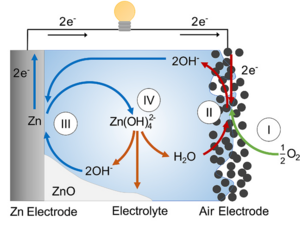Category:OSWe8eada7338114bbe8f65f6ee089d439f
|
|
| Line 1: |
Line 1: |
| | ==Overview== |
| | Zinc-air batteries are a type of metal-air battery technology that offers the potential for high energy density, inherent safety, and the use of affordable, earth-abundant materials. These characteristics have attracted interest for a wide range of energy storage applications, from hearing aids and sensors to large-scale stationary energy storage. Most zinc-air batteries commercially available today are ''primary cells'' (single-use), but there is growing research and development effort aimed at making zinc-air batteries ''secondary cells'' (rechargeable). This work is driven by the technology's promise to combine high performance with sustainability and low cost. |
|
| |
|
| | ==Working Principle== |
| | A typical zinc-air battery couples an oxygen reduction cathode with a zinc-based anode in an alkaline electrolyte. During discharge, oxygen from the air undergoes reduction at the cathode, while zinc metal at the anode is oxidized. In primary zinc-air batteries, the cathode is a porous gas diffusion electrode containing an oxygen reduction catalyst, such as manganese dioxide (MnO₂). The oxygen reduction reaction (ORR) proceeds according to: |
| | |
| | O₂ + H₂O + 4e⁻ ⇌ 4OH⁻ |
| | |
| | Rechargeable (secondary) zinc-air batteries use a bi-functional air cathode capable of both the oxygen reduction reaction (ORR) during discharge and the oxygen evolution reaction (OER) during charging. |
| | |
| | {{Template:Viewer/Media |
| | | image_size = 300 |
| | | mode = default |
| | | textdata = File:OSWd16c853933b64ebe9fe640d5a74e96f6.png{{!}}A schematic showing the working principle of an alkaline zinc-air battery cell. Reused with permission from N. Borchers, S. Clark, B. Horstmann, K. Jayasayee, M. Juel, and P. Stevens, “Innovative Zinc-Based Batteries,” J. Power Sources, 484, no. December 2020, p. 229309, 2021, https://doi.org/10.1016/j.jpowsour.2020.229309.; |
| | }} |
Revision as of 11:35, 15 April 2025
a type of metal-air battery with a zinc negative electrode
Overview
Zinc-air batteries are a type of metal-air battery technology that offers the potential for high energy density, inherent safety, and the use of affordable, earth-abundant materials. These characteristics have attracted interest for a wide range of energy storage applications, from hearing aids and sensors to large-scale stationary energy storage. Most zinc-air batteries commercially available today are primary cells (single-use), but there is growing research and development effort aimed at making zinc-air batteries secondary cells (rechargeable). This work is driven by the technology's promise to combine high performance with sustainability and low cost.
Working Principle
jsondata
| type | | "Category:OSW57beed5e1294434ba77bb6516e461456" |
|
|---|
| metaclass | | "Category:OSW57beed5e1294434ba77bb6516e461456" |
|
|---|
| restrictions | | uuid | "55866785-b333-4724-9a94-7f4719846b19" |
|---|
| rdf_type | "owl:Restriction" |
|---|
| on_property | "Property:echem:hasNegativeElectrode" |
|---|
| some_values_from | "Category:OSWd0a26dc2fde94a11ac267c18499d28a5" |
|---|
|
|
|---|
| subclass_of | | "Category:OSW9cfcb1d3ed39476a930047ffb6de6cf0" |
| "Category:OSWe1d7fb0003b946ea90c9501f538dfc11" |
|
|---|
| uuid | "e8eada73-3811-4bbe-8f65-f6ee089d439f" |
|---|
| label | | text | "ZincAirBattery" |
|---|
| lang | "en" |
|---|
|
|
|---|
| description | | text | "a type of metal-air battery with a zinc negative electrode" |
|---|
| lang | "en" |
|---|
|
|
|---|
| rdf_type | |
|---|
| iri | "https://w3id.org/emmo/domain/battery#battery_e8eada73_3811_4bbe_8f65_f6ee089d439f" |
|---|
| name | "ZincAirBattery" |
|---|
| meta | | uuid | "ee6dfa71-7311-4c44-b90a-662a9fe01669" |
|---|
| wiki_page | | title | "OSWe8eada7338114bbe8f65f6ee089d439f" |
|---|
| namespace | "Category" |
|---|
|
|---|
| change_id | | "4caad4a3-8d2d-4691-8196-627860411931" |
|
|---|
|
|---|
| imported_from | "battery:battery_e8eada73_3811_4bbe_8f65_f6ee089d439f" |
|---|
| altLabel | |
|---|
| image | "File:OSW921ee64cb7494f7db2971219d78a057c.jpg" |
|---|
| attachments | | "File:OSWd16c853933b64ebe9fe640d5a74e96f6.png" |
|
|---|
jsonschema
| @context | | "/wiki/Category:OSW9cfcb1d3ed39476a930047ffb6de6cf0?action=raw&slot=jsonschema" |
| "/wiki/Category:OSWe1d7fb0003b946ea90c9501f538dfc11?action=raw&slot=jsonschema" |
|
|---|
| allOf | | $ref | "/wiki/Category:OSWe1d7fb0003b946ea90c9501f538dfc11?action=raw&slot=jsonschema" |
|---|
|
|
|---|
| type | "object" |
|---|
| uuid | "e8eada73-3811-4bbe-8f65-f6ee089d439f" |
|---|
| title | "ZincAirBattery" |
|---|
| title* | |
|---|
| description | "a type of metal-air battery with a zinc negative electrode" |
|---|
| description* | | en | "a type of metal-air battery with a zinc negative electrode" |
|---|
|
|---|
| required | |
|---|
| properties | | type | | default | | "Category:OSWe8eada7338114bbe8f65f6ee089d439f" |
|
|---|
|
|---|
|
|---|
Subcategories
This category has the following 2 subcategories, out of 2 total.


